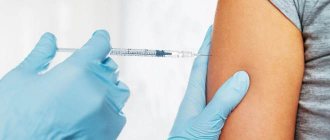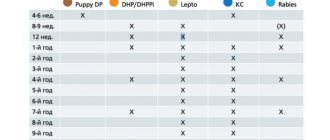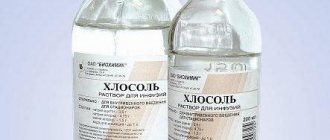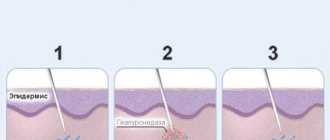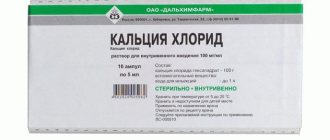Relevance
The benefit of using dexamethasone or betamethasone in pregnant women at risk of preterm birth has been shown in countries with high health care costs.
However, the cost-effectiveness of this intervention in countries with low health care costs is unknown. A new study assessed the effectiveness and safety of antenatal glucocorticoid use in women in countries with low health care costs.
Solution for intravenous and intramuscular administration Dexamethasone
Instructions for medical use of the drug
Description of pharmacological action
Long-acting corticosteroids for systemic use. It has a pronounced anti-inflammatory, antiallergic and desensitizing effect, and has immunosuppressive activity. Dexamethasone (like other corticosteroids) acts at the cellular level through two receptor systems in the cellular cytoplasm. By binding to glucocorticoid receptors, GCS have anti-inflammatory and immunosuppressive effects and regulate glucose homeostasis. By binding to mineralocorticoid receptors, GCS regulate the metabolism of sodium, potassium and water balance. After intravenous administration, the effect develops quickly; after intramuscular administration, the clinical effect is achieved within 8 hours. The effect of the drug is prolonged and lasts from 17 to 28 days after intramuscular administration and from 3 days to 3 weeks after local administration (to the affected area ). A 750 mcg dose of dexamethasone is equivalent to a dose of 4 mg methylprednisolone and triamcinolone, 5 mg prednisone and prednisolone, 20 mg hydrocortisone, and 25 mg cortisone.
Indications for use
— disorders of the endocrine system: acute insufficiency of the adrenal cortex; surgery, severe injury or illness in patients with known or suspected adrenal insufficiency; — shock of various origins: shock resistant to standard therapy; anaphylactic shock; shock in patients with adrenal insufficiency; - cerebral edema: swelling of the brain caused by primary or metastatic brain tumors, neurosurgery or traumatic brain injury; - malignant diseases: palliative treatment of leukemia and lymphoma in adults, acute leukemia in children, hypercalcemia in patients with malignant tumors in the absence of oral administration; - exacerbation of chronic obstructive bronchitis and bronchial asthma, status asthmaticus; - severe allergic reactions; - intra-articular administration: in cases of severe inflammation of the joint (except infectious), when conventional therapy is ineffective, as well as in other conditions with synovitis and effusion (after aspiration of synovial fluid); - local application (to the affected area) - in cases of fibrous-densified folliculitis, granuloma annulare and sarcoidosis; - subconjunctival, retrobulbar or parabulbar administration - in cases where there is a danger to vision due to inflammatory or allergic eye diseases, systemic immunodeficiency, proliferative changes in the orbit, sympathetic ophthalmia and immunosuppressive treatment after corneal transplantation; — diagnostic study of adrenal hyperfunction; - treatment of diseases for which the use of oral dexamethasone is impossible.
Release form
solution for intravenous and intramuscular administration 4 mg/ml; dark glass ampoule 1 ml cardboard pack 5; solution for intravenous and intramuscular administration 4 mg/ml; dark glass ampoule 1 ml cardboard pack 25; solution for intravenous and intramuscular administration 4 mg/ml; dark glass ampoule 2 ml cardboard pack 25; solution for intravenous and intramuscular administration 4 mg/ml; dark glass ampoule 2 ml cardboard pack 5; solution for intravenous and intramuscular administration 4 mg/ml; dark glass ampoule 1 ml cardboard pack 10; solution for intravenous and intramuscular administration 4 mg/ml; dark glass ampoule 1 ml cardboard pack 15; solution for intravenous and intramuscular administration 4 mg/ml; dark glass ampoule 1 ml cardboard pack 20; solution for intravenous and intramuscular administration 4 mg/ml; dark glass ampoule 2 ml cardboard pack 10; solution for intravenous and intramuscular administration 4 mg/ml; dark glass ampoule 2 ml cardboard pack 15; solution for intravenous and intramuscular administration 4 mg/ml; dark glass ampoule 2 ml cardboard pack 20; solution for intravenous and intramuscular administration 4 mg/ml; dark glass bottle (bottle) 1 ml cardboard pack 5; solution for intravenous and intramuscular administration 4 mg/ml; dark glass bottle (bottle) 1 ml cardboard pack 15; solution for intravenous and intramuscular administration 4 mg/ml; bottle (bottle) of dark glass 1 ml cardboard pack 25; solution for intravenous and intramuscular administration 4 mg/ml; dark glass bottle (bottle) 1 ml cardboard pack 10; solution for intravenous and intramuscular administration 4 mg/ml; dark glass bottle (bottle) 1 ml cardboard pack 20; solution for intravenous and intramuscular administration 4 mg/ml; dark glass bottle (bottle) 2 ml cardboard pack 5; solution for intravenous and intramuscular administration 4 mg/ml; dark glass bottle (bottle) 2 ml cardboard pack 10; solution for intravenous and intramuscular administration 4 mg/ml; dark glass bottle (bottle) 2 ml cardboard pack 15; solution for intravenous and intramuscular administration 4 mg/ml; dark glass bottle (bottle) 2 ml cardboard pack 20; solution for intravenous and intramuscular administration 4 mg/ml; dark glass bottle (bottle) 2 ml cardboard pack 25; solution for intravenous and intramuscular administration 4 mg/ml; 1 ml ampoule with ampoule knife, cardboard pack 10; solution for intravenous and intramuscular administration 4 mg/ml; 1 ml ampoule with ampoule knife contour plastic packaging (pallets) 5 cardboard pack 1; solution for intravenous and intramuscular administration 4 mg/ml; 1 ml ampoule with ampoule knife contour plastic packaging (pallets) 5 cardboard pack 2; solution for intravenous and intramuscular administration 4 mg/ml; 1 ml ampoule with ampoule knife contour plastic packaging (pallets) 10 cardboard pack 1; solution for intravenous and intramuscular administration 4 mg/ml; 1 ml ampoule with ampoule knife contour plastic packaging (pallets) 10 cardboard pack 2;
Pharmacodynamics
Long-acting corticosteroids for systemic use. It has a pronounced anti-inflammatory, antiallergic and desensitizing effect, and has immunosuppressive activity. Dexamethasone (like other corticosteroids) acts at the cellular level through two receptor systems in the cellular cytoplasm. By binding to glucocorticoid receptors, GCS have anti-inflammatory and immunosuppressive effects and regulate glucose homeostasis. By binding to mineralocorticoid receptors, GCS regulate the metabolism of sodium, potassium and water balance. After intravenous administration, the effect develops quickly; after intramuscular administration, the clinical effect is achieved within 8 hours. The effect of the drug is prolonged and lasts from 17 to 28 days after intramuscular administration and from 3 days to 3 weeks after local administration (to the affected area ). A 750 mcg dose of dexamethasone is equivalent to a dose of 4 mg methylprednisolone and triamcinolone, 5 mg prednisone and prednisolone, 20 mg hydrocortisone, and 25 mg cortisone.
Pharmacokinetics
Distribution and metabolism Binding to plasma proteins (mainly albumin) is 72%. Only minimal amounts of dexamethasone bind to non-albumin proteins. Dexamethasone is a fat-soluble compound. Initially metabolized in the liver. A small amount of dexamethasone is metabolized in the kidneys and other organs. Excretion Excreted mainly in urine.
Use during pregnancy
The use of Dexamethasone during pregnancy is possible only for health reasons, if the expected benefit of therapy for the mother outweighs the potential risk associated with treatment. Since the drug may affect the growth of the child and the secretion of endogenous corticosteroids, breastfeeding should be stopped while using Dexamethasone.
Contraindications for use
— osteoporosis; - acute viral, bacterial and systemic fungal infections (when appropriate treatment is not carried out); - Cushing's syndrome; - lactation period (breastfeeding); — idiopathic thrombocytopenic purpura (for intramuscular administration); — for use in ophthalmology: viral and fungal diseases of the eyes, acute form of purulent eye infection in the absence of specific therapy, diseases of the cornea combined with epithelial defects, trachoma, glaucoma; - hypersensitivity to dexamethasone and other components of the drug. Relative contraindications: chronic renal failure, liver cirrhosis or chronic hepatitis, acute psychosis.
Side effects
Administration of glucocorticoids parenterally or by local injection reduces the risk of systemic side effects. However, the risk of systemic and local side effects exists to some extent and increases with prolonged therapy and with increasing frequency of injections. With rapid intravenous administration in high doses: generalized anaphylaxis, redness of the face or cheeks, interruptions in heart function, convulsions. From the central nervous system and peripheral nervous system: rarely - mental disorders such as delirium (confusion, agitation, anxiety), disorientation, euphoria, hallucinations, manic-depressive episodes, depression or paranoia, glaucoma, cataracts, increased intraocular pressure and exophthalmos. Local reactions: Redness, swelling, pain or other signs of inflammation or an allergic reaction at the injection site are less common side effects. With prolonged use, stretch marks, tendon rupture, atrophy of the skin or subcutaneous tissue may be observed at the injection site. Other: rarely - generalized allergic skin reaction, sudden blindness, burning sensation, numbness, pain or tingling at or near the injection site.
Directions for use and doses
IM and IV administration The drug is administered IM, IV (stream or drip) with glucose or saline solution. Do not mix Dexamethasone with other medications in the same syringe or infusion bottle. The recommended initial average dose for IV or IM administration is 0.5-9 mg/day or, if necessary, more. During the day, you can administer from 4 to 20 mg of Dexamethasone 3-4 times. The duration of parenteral administration is usually 3-4 days, then they switch to maintenance therapy with the oral form of the drug. Intra-articular administration and local use For intra-articular administration, the recommended dose is from 0.4 mg to 4 mg once. Intra-articular injections can be repeated after 3-4 months; the drug can be administered a maximum of 3-4 times into the same joint during the year; the drug can be injected into 2 joints at the same time. More frequent use may damage the joint cartilage. The dose of the drug depends on the size of the affected joint. Typically, 2-4 mg of dexamethasone is injected into large joints, and 0.8-1 mg into small joints. The doses of dexamethasone that are injected into the bursa are 2-3 mg; doses that are injected into the tendon sheath are 0.4-1 mg; doses injected into the tendon are 1-2 mg. The dose of dexamethasone for injection into the affected area is equal to the intra-articular dose. The drug can be administered simultaneously into a maximum of 2 affected areas. For injection into the soft tissue around the joint, a dose of 2 to 6 mg is recommended. Doses for children with intramuscular administration When carrying out replacement therapy (for adrenal insufficiency), the dose is 23.3 mcg/kg (670 mcg/m2) for 3 injections every third day, or daily 7.76-11.65 mcg/kg (233 -335 µg/m2). For other indications, the recommended dose is from 27.76 to 166.65 mcg/kg every 12-24 hours.
Overdose
Symptoms: if the drug is used in high doses for several weeks, most of the side effects listed above and Cushing's syndrome may develop. Treatment: dose reduction or temporary discontinuation of the drug, symptomatic therapy. There is no special antidote. Hemodialysis is not effective.
Interactions with other drugs
The effectiveness of dexamethasone is reduced by concomitant use of rifampicin, carbamazepine, phenobarbital, phenytoin (diphenylhydantoin), primidone, ephedrine or aminoglutethimide. Dexamethasone reduces the effectiveness of hypoglycemic drugs, antihypertensive drugs, coumarin anticoagulants, praziquantel and natriuretics. Dexamethasone increases the activity of heparin, albendazole and kaliuretics. The simultaneous use of dexamethasone and corticosteroids in high doses or β2-adrenergic receptor agonists increases the risk of developing hypokalemia. Patients with hypokalemia have higher arrhythmogenicity and toxicity of cardiac glycosides. With the simultaneous use of oral contraceptives, the half-life of GCS may increase, which leads to an increase in their effect and an increase in the number of side effects. The simultaneous use of ritodrine and dexamethasone is contraindicated, because may cause death. The simultaneous administration of dexamethasone and metoclopramide, diphenhydramine, prochlorperazine or ondansetron or granisetron is effective for the prevention of nausea and vomiting caused by chemotherapy using cisplatin, cyclophosphamide, methotrexate, fluorouracil.
Special instructions for use
Use with caution in patients with arterial hypertension, heart failure, diabetes mellitus, epilepsy, thromboembolism, myasthenia gravis and glaucoma. The effect of GCS is enhanced in patients with liver cirrhosis or hypothyroidism. Treatment with dexamethasone may mask signs of existing or new infection. Dexamethasone can cause exacerbation of systemic fungal infection, latent amebiasis, and pulmonary tuberculosis. During treatment with dexamethasone, vaccination with a live viral vaccine is contraindicated. Immunization with a killed viral or bacterial vaccine does not induce the expected production of antibodies and does not have the expected preventive effect. Typically, dexamethasone is not prescribed 8 weeks before and 2 weeks after vaccination. Caution should be used when treating patients after surgery or bone fracture, as dexamethasone may slow wound healing and callus formation. Treatment with dexamethasone in children can be carried out only for absolute indications.
Storage conditions
List B.: At a temperature not exceeding 25 °C (do not freeze).
Best before date
24 months
ATX classification:
S Sense organs
S01 Drugs for the treatment of eye diseases
S01B Anti-inflammatory drugs
S01BA Corticosteroids
S01BA01 Dexamethasone
results
- The study included 2852 women and their 3070 fetuses. The women were observed in hospitals in Bangladesh, India, Kenya, Nigeria and Pakistan.
- The study was completed earlier than planned because the second interim analysis showed a clear benefit from steroid therapy.
- Neonatal death occurred in 278 of 1417 infants (19.6%) in the dexamethasone group and in 331 of 1406 infants (23.5%) in the placebo group (relative risk, 0.84; 95% CI, 0.72-0. 97; P=0.03).
- Stillbirth or neonatal death occurred in 393 of 1532 fetuses and infants (25.7%) in the dexamethasone group and in 444 of 1519 fetuses and infants (29.2%) in the placebo group (relative risk, 0.88; 95% CI, 0.78-0.99; P=0.04).
- The incidence of maternal bacterial infection was 4.8% with dexamethasone compared with 6.3% in the control group (relative risk, 0.76; 95% CI, 0.56-1.03).
- According to the safety analysis, there were no significant differences between the groups in the frequency of side effects.
Dexamethasone solution for injection 4 mg/ml 2 ml amp 10 pcs
Pharmacological group:
Glucocorticosteroid.
Pharmacodynamics:
Dexamethasone is a synthetic hormone of the adrenal cortex, a glucocorticosteroid (GCS), a methylated derivative of fluoroprednisolone. It has anti-inflammatory, antiallergic, desensitizing, antishock, antitoxic and immunosuppressive effects.
It interacts with specific cytoplasmic glucocorticosteroid receptors to form a complex that penetrates the cell nucleus and stimulates the synthesis of matrix ribonucleic acid, the latter inducing the formation of proteins, including lipocortin, that mediate cellular effects. Lipocortin inhibits phospholipase A2, suppresses the release of arachidonic acid and suppresses the synthesis of endoperoxides, prostaglandins, leukotrienes, which contribute to inflammation, allergies, etc.
Protein metabolism: reduces the amount of protein in plasma (due to globulins) with an increase in the albumin/globulin ratio, increases the synthesis of albumins in the liver and kidneys; enhances protein catabolism in muscle tissue.
Lipid metabolism: increases the synthesis of higher fatty acids and triglycerides, redistributes fat (fat accumulation occurs mainly in the shoulder girdle, face, abdomen), leads to the development of hypercholesterolemia.
Carbohydrate metabolism: increases the absorption of carbohydrates from the gastrointestinal tract (GIT); increases the activity of glucose-6-phosphatase, which leads to an increase in the flow of glucose from the liver into the blood; increases the activity of phosphoenolpyruvate carboxylase and the synthesis of aminotransferases, which leads to the activation of gluconeogenesis.
Water-electrolyte metabolism: retains sodium (Na+) and water in the body, stimulates the excretion of potassium (K+) (mineralocorticoid activity), reduces the absorption of calcium (Ca2+) from the gastrointestinal tract, “washes out” Ca2+ from the bones, increases the excretion of Ca2+ by the kidneys.
The anti-inflammatory effect is associated with inhibition of the release of inflammatory mediators by eosinophils; inducing the formation of lipocortin and reducing the number of mast cells that produce hyaluronic acid; with a decrease in capillary permeability; stabilization of cell membranes and organelle membranes (especially lysosomal ones).
The antiallergic effect develops as a result of suppression of the synthesis and secretion of allergy mediators, inhibition of the release of histamine and other biologically active substances from sensitized mast cells and basophils, a decrease in the number of circulating basophils, suppression of the development of lymphoid and connective tissue, a decrease in the number of T- and B-lymphocytes, mast cells , reducing the sensitivity of effector cells to allergy mediators, suppressing antibody formation, changing the body’s immune response.
In chronic obstructive pulmonary disease, the effect is based mainly on inhibition of inflammatory processes, inhibition of development or prevention of swelling of the mucous membranes, inhibition of eosinophilic infiltration of the submucosal layer of the bronchial epithelium, deposition of circulating immune complexes in the bronchial mucosa, as well as inhibition of erosion and desquamation of the mucous membrane. Increases the sensitivity of beta-adrenergic receptors of small and medium-caliber bronchi to endogenous catecholamines and exogenous sympathomimetics, reduces the viscosity of mucus by inhibiting or reducing its production.
Antishock and antitoxic effects are associated with an increase in blood pressure (BP) (due to an increase in the concentration of circulating catecholamines and restoration of the sensitivity of adrenergic receptors to them, as well as vasoconstriction), a decrease in the permeability of the vascular wall, membrane protective properties, and activation of liver enzymes involved in the metabolism of endo- and xenobiotics .
The immunosuppressive effect is due to inhibition of the release of cytokines (interleukin-1 and interleukin-2, interferon gamma) from lymphocytes and macrophages.
Therefore, it has a 30 times more pronounced effect than endogenous cortisol.
Dexamethasone has a 30 times more pronounced effect than endogenous cortisol. Therefore, it is a more potent inhibitor of the secretion of corticotropin-releasing hormone and ACTH. In pharmacological doses, it inhibits the hypothalamic-pituitary-adrenal system and promotes the development of secondary adrenal insufficiency. Suppresses the synthesis and release of adrenocorticotropic hormone (ACTH) by the pituitary gland and, secondarily, the synthesis of endogenous GCS. Inhibits the secretion of thyroid-stimulating hormone and follicle-stimulating hormone. Suppresses the release of beta-lipotropin, but does not reduce the content of circulating beta-endorphin.
Inhibits connective tissue reactions during the inflammatory process and reduces the possibility of scar tissue formation.
Increases the excitability of the central nervous system, reduces the number of lymphocytes and eosinophils, and increases the number of red blood cells (by stimulating the production of erythropoietin).
The peculiarity of the action is significant inhibition of pituitary function and the almost complete absence of mineralocorticoid activity.
Pharmacokinetics:
Absorption
The maximum concentration of dexamethasone in the blood plasma is achieved within 5 minutes after intravenous administration and 1 hour after intramuscular administration.
Distribution
The binding to plasma proteins (mainly albumin) is 77%. Penetrates through the blood-brain and placental barriers. The half-life (T1/2) from plasma is 190 minutes.
Metabolism
Metabolized in the liver. A small amount of dexamethasone is metabolized in the kidneys and other organs.
Removal
Up to 65% of the dose is excreted by the kidneys within 24 hours.
Time to develop clinical effect
When administered intravenously, the action develops quickly; with intramuscular use, the clinical effect develops after 8 hours. The effect is long-lasting: from 17 to 28 days after intramuscular use and from 3 days to 3 weeks after topical application. When administered locally into joints or soft tissues (into lesions), absorption occurs more slowly than with intramuscular use.
